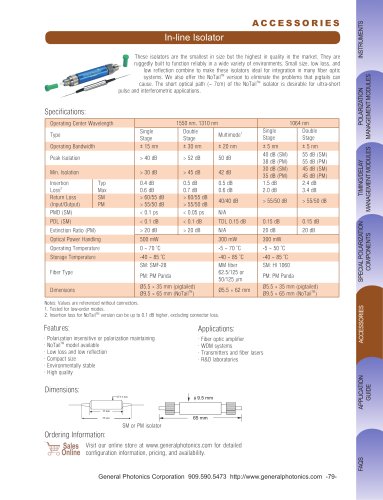
Catalog excerpts
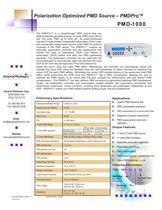
General Photonics Corp. 5228 Edison Ave. Chino, CA 91710 Tel: 909.590.5473 Fax: 909.902.5536 Email: info@generalphotonics.com Website: www.generalphotonics.com Preliminary Specifications Operating Wavelength Range1 C band or L band Insertion Loss (at 1550nm) 5.0 dB Input power range -10 ~ 15 dBm Return Loss 50 dB P DL 0.4 dB typical 1 st order PMD Range 0 ~ 91 or 0 ~ 182 ps 9 0 ps range 1 80 ps range D iscrete mode 0 .357 ps 0. 714 ps 1 st order PMD resolution Quasi-continuous mode 0.1 ps 0.2 ps 2nd Order PMD Range 2000 ps2 (90 ps range) or 8200 ps2 (180 ps range) PMD wavelength dependence No wavelength dependence in quasi-continuous mode PMD variation time 1 ms min. SOP alignment accuracy ±2° SOP tracking speed 10ð/s DOP accuracy ± 2% Optical Power Handling 300 mW min. Operating Temperature 10 °C to 50 °C Wavelength: C = C band L = L band
Open the catalog to page 1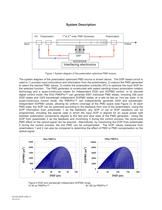
System Description GP-DS-PMD-1000-13 10/14/10 Figure 1 System diagram of the polarization optimized PMD source. The system diagram of the polarization optimized PMD source is shown above. The DSP based circuit is used to 1) process input instructions and information from the polarimeters, 2) instruct the PMD generator to select the desired PMD values, 3) control the polarization controller (PC) to optimize the input SOP for the selected function. The PMD generator is constructed with patent pending trinary polarization rotation technology and a quasi-continuous rotator for independent DGD...
Open the catalog to page 2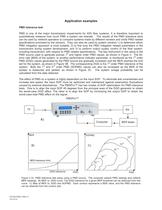
Application examples PMD tolerance test PMD is one of the major transmission impairments for 40G fiber systems. It is therefore important to quantitatively measure how much PMD a system can tolerate. The results of the PMD tolerance tests can be used by network operators to compare systems made by different vendors and verify PMD related specifications promised by the vendors. They can also be used by system vendors 1) to determine which PMD mitigation approach is most suitable, 2) to fine tune the PMD mitigation related parameters in the transceivers during system development, and 3) to...
Open the catalog to page 3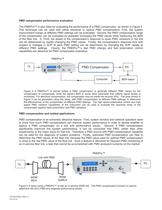
PMD compensator performance evaluation The PMDPro™ is also ideal for evaluating the performance of a PMD compensator, as shown in Figure 4. This technique can be used with either electrical or optical PMD compensators. First, the system improvement margin at different PMD settings can be evaluated. Second, the PMD compensation range of the compensator can be evaluated by gradually increasing the PMD values while measuring the BER of the fiber link. 3) Third, the speed of the compensator’s response to quick PMD variations in the link can be determined by rapidly changing the PMD values....
Open the catalog to page 4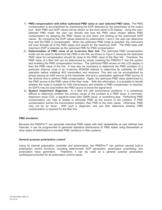
1) PMD compensation with either optimized PMD value or user selected PMD value. The PMD compensation is accomplished by maximizing the DOP detected by the polarimeter at the output port. Both PMD and DOP values will be shown on the front panel LCD display. Using the user-selected PMD mode, the user can directly see how the PMD value chosen affects PMD compensation by stepping the PMD values up and down and looking at the maximized DOP values. By comparing the DOP values obtained by polarimeters 1 and 2, the user can determine how well the PMD is compensated. When the optimized PMD mode is...
Open the catalog to page 5All General Photonics catalogs and technical brochures
-
Drop In Coupler, NoTail
1 Pages
-
Micro Polarization Scrambler
1 Pages
-
Fiber Phase Shifter
1 Pages
-
Polarization State Generator
1 Pages
-
Polarization Switch
1 Pages
-
TimeRITE
1 Pages
-
MPC-201
2 Pages
-
ERM-202
1 Pages
-
PXA-1000
2 Pages
-
MPC-202
2 Pages
-
WSL-1000
1 Pages
-
PolaMIX?
1 Pages
Archived catalogs
-
3 Port Circulator, NoTail
1 Pages
-
Detector, USB Powered
1 Pages
-
Bare Fiber Adapter
1 Pages
-
Fiber Optic Depolarizer
2 Pages
-
In Line Isolator, NoTail
1 Pages
-
Fiber Stretcher
1 Pages
-
Highly Stable SLED Sources
1 Pages

































